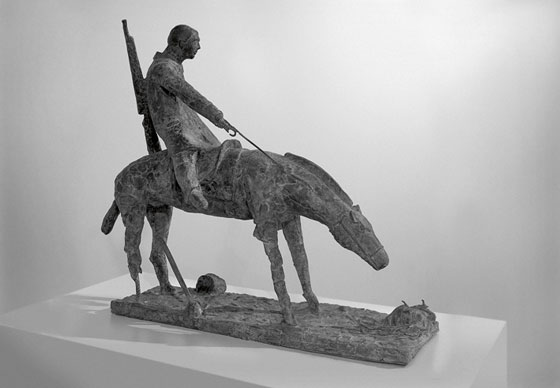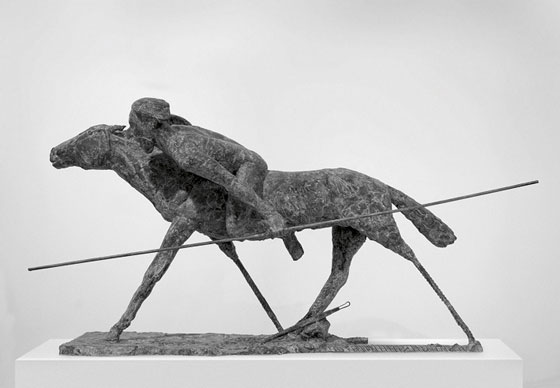|
|
| Looking for tears in the beards of comics Pēteris Bankovskis, Art Critic Time Will Save History. Documentary sculpture collection by Aigars Bikše and stories by Māris Bērziņš 18.11.–14.12.2010. Māksla XO Gallery | |
 Aigars Bikše. Latvian Red Rifleman Five Minutes before an Aerial Bomb Explodes. Bronze. 67x32x58 cm. 2008-2010. Photo: Jana Briķe | |
| History is full of amusing comedy duos: Pat and Patachon, Laurel and Hardy, Tarapunka and Shtepsel, Putin and Medvedev, Ozoliņš and Raudseps, Rozenbergs and Dreiblats, just to name a few. At the end of last year, with the assistance of the Māksla XO Gallery, they were joined by another comic double act: Bikše and Bērziņš. These two men, sculptor Aigars Bikše and ‘openness activist’ and writer Māris Bērziņš, held an exhibition at the gallery under the title Time Will Save History. The title is truly worthy of this comic pair, especially since the introductory text to the exhibition states that “history, like the past, does not exist – they are myths”. What the authors meant by the title of the exhibition and the quoted assertion it is difficult to say, but contemporary art is not intended to make us comprehend anything, except perhaps that the creators of this art consider the way they spend their lives to be somehow better than what the rest of us can manage. And that, because of this, they have the right or even duty to impose on others the ‘products’ of their lives. After all, it’s abundantly clear the neither Bikše nor Bērziņš, nor even the greatest minds of the world’s universities can say what time actually is, let alone try to explain what it will or won’t save. Likewise, what are we to make of the assertion that the history and past ‘in need of saving’ do not exist, that they are no more than myths? How can these lads know that myths do not exist? How do they know they themselves are not mythological beings? And how can anyone actually know what exists and what doesn’t? So much for that. During the time of the exhibition, anyone who passed the Māksla XO Gallery could see through the window an enormous centaur statue with a kind of log over its shoulder. As transpires from what Māris Bērziņš has written, this wooden sculpture represents Putin who, with the help of the secret service, has been changed into a centaur for a few days, so that he can prance along the border with Chechnya in that guise with a bazooka on his shoulder. | |
 Aigars Bikše. Rainis at Castagnola 9 Years before the Founding of the Republic of Latvia. Composite material. 31x70x50 cm. 2010. Photo: Jana Briķe | |
| Further to the back of the gallery, you could look at another six of Bikše’s sculptures, four of them cast in bronze (one with the proud inscription stating that it was done in China), the other two not. From a distance, the style of the sculptures is reminiscent of the techniques used by Lithuanian sculptors some twenty years ago. However, that’s not really important on this occasion. The sculptures probably were not intended to have any particular value in their own right. An exception, perhaps, is the figure of Jesus Christ, evidently obtained ready-made from somewhere or other. Whether the artist intended it that way or not, it does have an innate value in terms of being openly blasphemous (with a sickle and hammer instead of hands, so that the statuette has been deliberately degraded and disfigured). Be that as it may, the sculptural figures do obtain some sort of bouquet of meaning in conjunction with the texts by Māris Bērziņš. The texts are long, and it was necessary to spend a good hour in the exhibition in order to read them carefully. The gallerists were especially pleased about this: it’s not too often that visitors to a contemporary art exhibition stay for more than a couple of minutes. It seems that it was very interesting for Bikše and Bērziņš to assert that in the contemplative space between the figurine made by one and the fairy-tale written by the other there occurred a process before something: before the end of a war, before the founding of a republic, before the quelling of a rising, etc. They put together a ‘what if...’ speculation, which people have always found engrossing, with standard assertions based on ‘facts’. For example, that Chechnya, Putin etc. actually exist; that the Republic of Latvia was once actually founded and that Rainis once upon a time lived not only in the imagination of Gundega Grīnuma, but also in Castagnola; that the ‘National Revival’ happened; that Lenin has been in Riga. The comic sketches by Bērziņš, which perhaps do not have great literary value, acquire meaning on a stage, as is characteristic of texts in this genre. In this case it is the gallery that serves as the stage, and the lampoonery is played out in the form of three-dimensional illustrations by Bikše. | |
 Aigars Bikše. Namejs Training at Spear-Throwing Three Days before a Battle with the German Crusaders. Bronze. 92x47x30 cm. 2009-2010. Photo: Jana Briķe | |
| The social (humanly created) World is affirming itself, more and more definitely, to be a comic misunderstanding. The economy is laughable, with all its science of economics and hordes of usurers, who claim to be the ‘blood circulation’ of everything in existence. The politics of power are laughable, when drawn out into the limelight by marginal figures such as an assange. Public opinion is laughable when we see that, with the decrepitude of a dying unrepentant sinner, even Christmas can be renamed in the formerly European ‘ecumenism’. The ‘public sphere’ of today, consisting of the so-called intellectuals (advertising executives, journalists and all kinds of office plankton), is full of merriment: popular in Latvia, too, are corporate parties, radio antics, the anecdotes of Šlāpins, Sex and the City and Facebook/Twitter. These are all ways in which the naked, trembling human being seeks refuge from global spying, supervision and control, which is coming to enslave every individual more and more determinedly. As always, this World is facing its demise, and so that it doesn’t have to weep unremittingly in horror at its own biography, it takes to irony and ridicule. Bikše and Bērziņš are part of this World, and sing along to the ditty, just like the rest of us. They do it, if for no other reason, then for the sake of their careers. However, if it’s not to turn into a dread-ful burlesque, no buffoonery can do without a note of true sorrow. At the exhibition in the Māksla XO Gallery, sorrow about the past that is never to return, but nevertheless truly exists in the soul, is expressed quite realistically in the text and illustration Pupils of Grade 10 at the 1 May Demonstration Five Years before the National Revival. While the rest of the exhibits ‘tell’ of things that, strictly speaking, are nothing to do with the artists, you can sense that the work Pupils of Grade 10... relates to their own lives. And then the myth and the brand disappear, and only the living person remains. /Translator into English: Valdis Bērziņš/ | |
| go back | |







